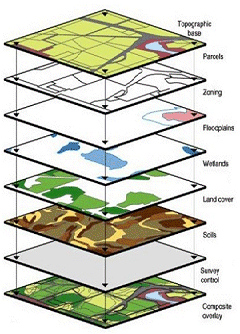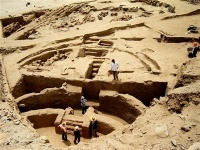Difference between revisions of "Geographic Information Systems"
(→GIS Code of Ethics) |
|||
| Line 47: | Line 47: | ||
==Ethical Implications== | ==Ethical Implications== | ||
===GIS Code of Ethics=== | ===GIS Code of Ethics=== | ||
| − | + | Since GIS is a multidisciplinary technical field and ethical codes are typically meant to serve only a single discipline or society, some have argued that many ethical issues surrounding GIS have not been addressed. Mason and Collins pinpointed issues of privacy, property, accuracy, and accessibility to be the four main concerns regarding information sciences that need to be ethically acknowledged. In order to address these concerns, the Urban and Regional Information Systems Association (URISA) adopted a GIS code of ethics in 2003. The philosophy of the ethical code stems from the teachings of philosopher Emanuel Kant (1724-1804), who was a geographer in his day and was very familiar with maps as a form of communication. Kant’s basic moral ideas were to always treat others with respect and never as means to an end. He encouraged individuals to consider the impact of their actions on other people and to modify their actions accordingly. The main points of the GIS Code of Ethics that developed out of Kant's moral philosophy is summarized below: | |
*Do the best work possible. | *Do the best work possible. | ||
Revision as of 03:44, 25 April 2018
Geographic Information Systems (GIS) is a data analysis method that integrates hardware, software, and data for the analysis of geographically-concerned data.[1] GIS can be used to capture, store, check, and display data that is related to positions on Earth’s surface. By storing all of this information in one map, GIS enables people to more easily analyze and understand geographic patterns and relationships. While GIS is an essential and prominent aspect of modern mapmaking, or cartography, it also contains a large variety of data that cannot be displayed in a printed or onscreen map.[2] GIS can also be used for a diverse amount of functions beyond mapping, such as: accident and hot spot analysis, urban planning, transportation planning, environmental impact analysis, disaster management and mitigation, and navigation services for example.[3] The main concepts behind GIS can be related as these 4 simple ideas: create it, manage it, analyze it, and display it.[4] The birth of GIS has also led to discussions regarding the privacy, property, accuracy, and accessibility of information.
Contents
History of GIS
The history of geographic information systems can be broken down into three primary stages[5]:
- Pioneering and Development
- GIS Software Commercialization
- User Adoption
- Mid-1800s to 1960[5]
- The start of GIS practices can be traced back to London in the mid-1800s where the city was in the midst of cholera epidemic due to rapid urbanization and poor sanitation methods. An anesthesiologist by the name of John Snow created maps charting these deaths caused by cholera. Not only was Snow able to stop the epidemic by removing the handle on a water pump but he was able to confirm that cholera was a disease that was transmitted through the consumption of contaminated water and that it was not an airborne disease. This also prompted a renewed effort to improve sanitation and the sewage infrastructure of London. By mapping the disease mortality of cholera, Snow applied the basics of geographic information systems.[6]
- It should be noted that geographic information systems can be created both through computer programs and on paper.)[5]
- 1960-1975[5]
- GIS visualizations continued to be done on paper up until the 1960s when desires from cartographers and spatial users pushed to explore newly invented computing options for handling geographic data. Between the years of 1960 and 1975, there were several major technological advances that also allowed for the increased development of GIS. Those advancements included: map graphics as outputs using line printers, advances in data storage with mainframe computers, and recording coordinates as data input. [5]
- Within this period of time we see the introduction of Roger Tomlinson who is widely regarded to be the father of GIS. During Tomlinson’s tenure with the Canadian government throughout the 1960s he was directly responsible for initiating, planning, and directing the development of the Canadian Geographic System (CGIS). (CGIS is considered by many to be the roots of modern geographic information systems.) The development of the system began in 1964 but was not fully functional until 1971.[5]
- However, the CGIS group was not the only organization adopting GIS. The US Census Bureau was also an early adopter of the core principals behind GIS. It was the work down by the US Census Bureau that ultimately led to the data format GBF-DIME (Geographic Base File – Dual Independent Map Encoding) being used. This data format allowed for digital data input, error fixing, and even choropleth mapping and also allowed for the US Census Bureau to begin digitizing roads, urban areas, and Census boundaries.[5]
- 1975-1990[5]
- During the mid-1970s, Harvard Laboratory for Computer graphics developed the first vector based GIS called the ODYSSEY GIS. This development played a critical role in the technical framework of what would lead into a period of software commercialization. With memory size and graphics capabilities improving, new cartography software was created which led to the 1980s seeing an increasing amount of GIS software vendors. One of those vendors was Esri – which would later become the largest GIS software company in the world and who would come to play a key role in the further development of GIS software.
- By this point in time GIS had gained notoriety through the holding of conferences and its use in published work. The first GIS conference was held in the UK in 1975 and only included a very small group of academics. The first conference held by the preeminent Esri was held in 1981 and had 18 participants. From there, GIS consultancy firms began to sprout.
- 1990-2010[5]
- During this time period, GIS experiences rapid user adoption and proliferation. The three main reasons for this phenomenon are: cheaper, faster, and more powerful computers, multiple software options and data availability, and the launch of new satellites and integration of remote sensing technology. However, the advancements in technology soon surpassed the capabilities of average users who did not know how to take full advantage of the software. This made many users and companies hesitant to adopt the software.
- Eventually, the importance of spatial analysis for decision-making was recognized and GIS began to be introduced into companies and classrooms. With increasing amounts of different data types being able to be processed by GIS software along with the availability of global position systems, users had more tools at their disposal than ever and the accuracy of these systems was greatly increased. These two factors led to further rampant development of geographic information and global positioning systems.
- 2010-Present[5]
- GIS software and data has now become virtually ubiquitous. There are massive online repositories of GIS that can be downloaded for free by anyone and there is also a nearly endless range of GIS software products. One of the biggest developments has been the fact that many GIS users are building their own GIS software in an open and collaborative way online that is available to the general public. QGIS is one of the best examples of open source GIS software.
- As of today, we have barely scratched the surface of what GIS is capable of.
Applications of GIS
GIS is useful for any spatial analysis, and therefore has a wide range of uses. Two examples of such uses are academic researchers in archaeology or biology can utilize GIS to create 3d models of archaeological dig sites or to picture species distribution in an area.[7] There is a high demand for experts in GIS in a multitude of public and private sectors[8] due to the ability of GIS to utilize diverse types of datasets for the mapping and analysis of any spatial phenomena[9].
Archaeology
Due to the inherently destructive nature of archaeology, archaeologists find it helpful to plot their site in GIS, utilizing careful measurements to plot a 3d model of the artifacts they recover in the positions they were in before the dig. In doing this, they have a complete model to utilize year-round in research. This is helpful, because many conclusions made about a site of habitation depend on the relative location of artifacts to one another, e.g. many types of charred bones could indicate a hearth or a trash pile, while concentrations of domestic items could suggest a home or workspace.[10]
Utility Companies
Utility companies deal with the distribution of electricity, water, etc. along networks. By mapping these networks in GIS, one is able to do spatial analysis to determine coverage deficiencies or best practices for expansion. The applications of GIS in this context have been referred to as the 4Ms: modeling, mapping, maintenance, and monitoring.[11]
Ethical Implications
GIS Code of Ethics
Since GIS is a multidisciplinary technical field and ethical codes are typically meant to serve only a single discipline or society, some have argued that many ethical issues surrounding GIS have not been addressed. Mason and Collins pinpointed issues of privacy, property, accuracy, and accessibility to be the four main concerns regarding information sciences that need to be ethically acknowledged. In order to address these concerns, the Urban and Regional Information Systems Association (URISA) adopted a GIS code of ethics in 2003. The philosophy of the ethical code stems from the teachings of philosopher Emanuel Kant (1724-1804), who was a geographer in his day and was very familiar with maps as a form of communication. Kant’s basic moral ideas were to always treat others with respect and never as means to an end. He encouraged individuals to consider the impact of their actions on other people and to modify their actions accordingly. The main points of the GIS Code of Ethics that developed out of Kant's moral philosophy is summarized below:
- Do the best work possible.
- Contribute to the community.
- Speak out about issues.
- Have a professional relationship.
- Respect others.[12]
Issues of Social Concern
Social phenomena that are measured like crime rates, poverty, education levels, segregation, etc. can be mapped spatially to serve as a tool for analysis. By providing a visual representation of geographic concentrations of various phenomena, correlations can be drawn and efforts can be focused on microcommunity-specific problems in order to affect maximum change
See Also
External Links
References
- ↑ what-gis http://www.gis.com/content/what-gis
- ↑ http://www.nationalgeographic.org/encyclopedia/geographic-information-system-gis/
- ↑ http://grindgis.com/blog/gis-applications-uses
- ↑ http://gisgeography.com/what-gis-geographic-information-systems/
- ↑ 5.0 5.1 5.2 5.3 5.4 5.5 5.6 5.7 5.8 5.9 http://gisgeography.com/history-of-gis/
- ↑ https://www.ncbi.nlm.nih.gov/pmc/articles/PMC3174470/
- ↑ who-uses-gis http://www.gis.com/content/who-uses-gis
- ↑ careers http://www.gis.com/content/careers-gis
- ↑ Colorado.edu http://www.colorado.edu/geography/gcraft/notes/datacon/datacon_f.html
- ↑ Stanford.edu http://www-sul.stanford.edu/depts/gis/Archaeology.htm
- ↑ Google http://books.google.com/books?vid=ISBN0849320976&id=ctWXJrDRf_AC&pg=PA1&lpg=PA1&ots=XxCU2Dm_0M&dq=GIS+Applications&sig=6whvFAGVG4SejGA9-Ys0HXddOqc#v=onepage&q&f=false
- ↑ Snow, M., Snow, R. Campus-Wide Information Systems. Ethics in the information exploitation and manipulation age (2007). 24.3 pg. 207-16.


